Introduction
In today’s fast-paced digital world, the demand for immersive and engaging content is at an all-time high. Whether it’s for gaming, animation, architecture, or product design, 3D models have become an essential element. This article delves into the fascinating realm of 3D models, their applications, creation process, and how they’ve transformed various industries.
Chapter 1: Understanding 3D Models
3D models, also known as three-dimensional models, are digital representations of objects or scenes created with the help of specialized software. These models, often called 3D assets, come in various forms, including wireframes, solid models, and surface models.
1.1 Types of 3D Models
Wireframe Models: These models represent the object using a network of lines and vertices. They are minimalistic in design, mainly showcasing the object’s structure without any surface or texture details.
Solid Models: Solid models are complete representations of an object. They provide both the surface and the interior details, making them suitable for various engineering and manufacturing applications.
Surface Models: These models focus on the surface of the object, representing the visible exterior. They are commonly used in industries like entertainment and gaming.
1.2 Applications of 3D Models
3D models have transformed numerous industries, including:
Gaming: In the gaming world, 3D models bring characters, environments, and objects to life. Players can interact with and explore these virtual worlds, immersing themselves in richly detailed environments.
Architectural Visualization: Architects use 3D models to create lifelike representations of buildings and landscapes. This aids in design development and presenting ideas to clients.
Medical Imaging: In the medical field, 3D models are used to visualize complex anatomical structures and plan surgeries. They offer a better understanding of patients’ conditions and aid in precision medical procedures.
Product Design: Manufacturers and designers create 3D models of products to evaluate and optimize their designs before production. This reduces errors and saves both time and resources.
Film and Animation: In the world of entertainment, 3D models are the backbone of computer-generated imagery (CGI) in movies and animations. These models enable the creation of stunning visuals and special effects.
Chapter 2: The Creation Process

Creating 3D models is a fascinating and intricate process that involves several steps. Here’s an overview of how 3D models are made:
2.1 Conceptualization
The process starts with a clear vision of what the 3D model should be. This often involves brainstorming and sketching to define the model’s purpose, design, and functionality.
2.2 Modeling
Modeling is where the magic happens. There are various 3D modeling techniques, including:
Polygon Modeling: This technique involves creating 3D models using polygons (usually triangles or quads) to define the model’s shape. It’s the most common method for creating game assets.
NURBS Modeling: Non-uniform rational B-spline (NURBS) modeling uses mathematical curves and surfaces to create smooth, high-quality models. It’s commonly used in industries like automotive and aerospace.
Sculpting: Sculpting involves digitally manipulating a model as if it were a piece of clay. It’s particularly useful for creating organic, highly detailed models, such as characters.
Procedural 3D Modeling: This method generates models algorithmically, allowing for quick and parametric design changes. It’s often used for creating landscapes and textures.
2.3 Texturing
Texturing adds realism to 3D models by applying surface patterns and colors. This step includes UV mapping, which ensures that textures align correctly with the model’s surface.
2.4 Rigging and Animation
For models that require movement, rigging and animation are crucial. Rigging involves creating a digital skeleton (rig) for the model, enabling it to move realistically. Animations bring the model to life by defining how it moves and interacts with its environment.
2.5 Rendering
Rendering is the process of converting the 3D model into a 2D image or animation. It involves adding lighting, materials, and camera settings to achieve the desired visual output.
2.6 Optimization
To ensure that 3D models run smoothly in applications and games, they often undergo optimization. This includes reducing the model’s polygon count, simplifying geometry, and creating level-of-detail (LOD) models for different viewing distances.
Chapter 3: The Importance of 3D Models in Different Industries

The versatility of 3D models is evident in their extensive applications across various industries.
3.1 Gaming and Entertainment
In the gaming and entertainment industry, 3D models are the backbone of virtual worlds and characters. High-quality 3D models are essential for creating immersive gaming experiences and captivating movies and animations.
The demand for 3D models in this industry has led to the growth of 3D modeling and animation studios, where artists and designers create stunning virtual assets. These assets are then integrated into game engines and animation software to produce interactive content.
3.2 Architecture and Real Estate
Architects and real estate developers use 3D models to bring their designs to life. These models allow clients and stakeholders to visualize architectural plans, interiors, and landscapes in a realistic and immersive way.
Moreover, 3D models are invaluable for urban planning and development. They help city planners and authorities make informed decisions about infrastructure and public spaces.
3.3 Healthcare and Medical Imaging
In the healthcare sector, 3D models play a vital role in medical imaging and treatment planning. Surgeons use 3D models to simulate complex surgeries, plan the best approach, and practice procedures before operating on patients. This technology improves surgical precision and patient outcomes.
Additionally, 3D models are used to create patient-specific prosthetics and orthopedic implants. By tailoring these devices to an individual’s anatomy, patients experience greater comfort and functionality.
3.4 Product Design and Manufacturing
3D models are at the heart of product design and manufacturing. Designers use CAD (Computer-Aided Design) software to create detailed 3D models of products, which can be easily modified and refined before going into production.
Manufacturers benefit from 3D models by using them to streamline the production process, reduce errors, and optimize resource usage. These models also assist in creating prototypes and molds for various industries, from consumer goods to automotive.
3.5 Education and Training
3D models are a powerful educational tool. They help students and professionals gain a deeper understanding of complex concepts, such as biology, physics, and engineering. Virtual dissections, interactive simulations, and anatomy models are just a few examples of how 3D models are used in education.
In training scenarios, 3D models allow learners to practice tasks in a risk-free environment. For instance, pilots use flight simulators with 3D models to develop their skills without taking to the skies.
Chapter 4: Challenges in 3D Modeling
While 3D models offer tremendous benefits, they also present unique challenges. Here are some common hurdles in the world of 3D modeling. To navigate these tools and master the art of 3D modeling can be a daunting task. However, with dedication and practice, individuals can overcome this challenge and produce impressive 3D models.
4.2 Resource Intensity
High-quality 3D models often demand significant computational resources. Complex models with detailed textures and animations can be computationally intensive to create and render. This means that not all hardware configurations can effectively handle the demands of 3D modeling.
Furthermore, the storage space required for large 3D models and their associated textures and animations can be substantial. Cloud-based solutions and external storage systems can help alleviate this issue.
4.3 Intellectual Property and Copyright Issues
3D models, like any other creative work, are subject to intellectual property laws. Copyright, licensing, and ownership rights can become complex, especially when 3D models are shared, sold, or integrated into different projects. Creators and users must be mindful of these legal aspects and obtain the necessary permissions or licenses when using or distributing 3D models.
4.4 Cross-Platform Compatibility
Ensuring that 3D models work seamlessly across different platforms and software applications can be challenging. Format conversions, file size optimization, and compatibility issues can arise when trying to use 3D models across various systems, making it essential to consider compatibility from the outset of a project.
Chapter 5: The Future of 3D Models
As technology continues to advance, the future of 3D modeling looks promising. Several developments are shaping the trajectory of 3D models in various industries.
5.1 Augmented and Virtual Reality
The integration of 3D models with augmented reality (AR) and virtual reality (VR) has been a game-changer. These technologies enable users to interact with 3D models in real-time, creating immersive experiences in education, gaming, and training. For instance, AR apps allow users to place 3D models of furniture in their real-world environments to preview how they would look.
5.2 3D Printing
3D printing has made it possible to bring digital 3D models into the physical world. This technology is revolutionizing manufacturing, product development, and even healthcare. Custom-made prosthetics, architectural models, and consumer goods can be created with remarkable precision using 3D printing technology.
5.3 Artificial Intelligence and Automation
Artificial intelligence (AI) and machine learning are streamlining the 3D modeling process. AI-powered tools can assist in tasks such as texturing, rendering, and even auto-generating 3D models based on verbal descriptions. This has the potential to make 3D modeling more accessible and efficient for a wider range of users.
5.4 Cloud-Based Collaboration
Cloud-based platforms are facilitating collaboration on 3D models across different locations and teams. With real-time updates and easy sharing capabilities, these platforms are fostering a more seamless workflow for professionals in architecture, animation, and product design.
5.5 Sustainability
Sustainability is a growing concern in 3D modeling and design. The ability to create efficient, lightweight 3D models that consume fewer resources is becoming increasingly important. Reducing the environmental impact of 3D modeling is a significant focus for many industries, particularly automotive and manufacturing.


Comments are closed.